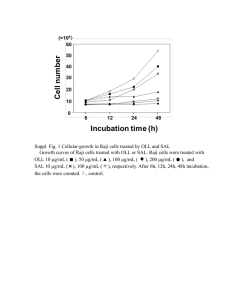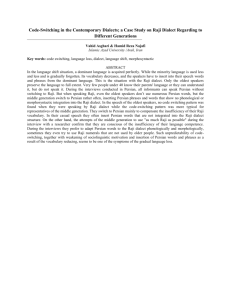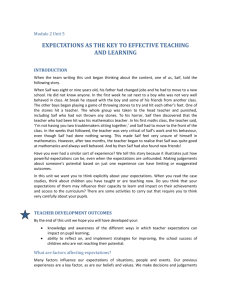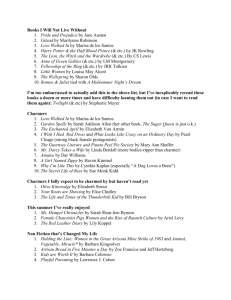Medium term plan – Summer 2 2008 Y5 approx 6 weeks
advertisement
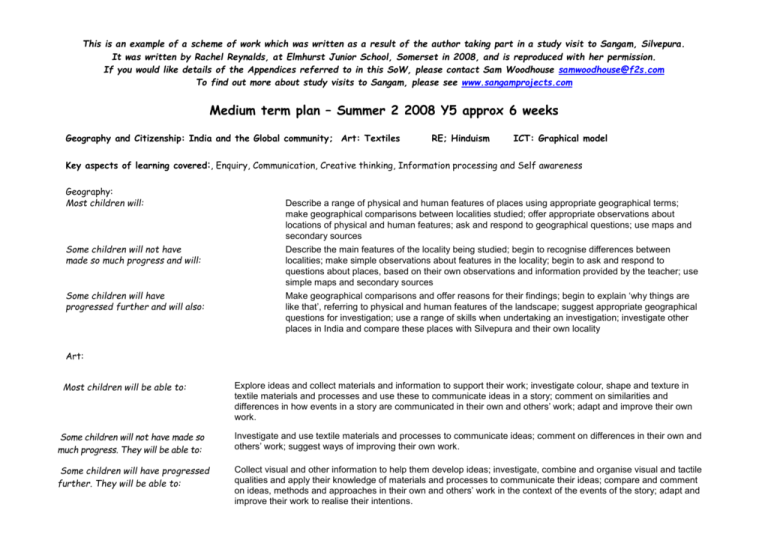
This is an example of a scheme of work which was written as a result of the author taking part in a study visit to Sangam, Silvepura. It was written by Rachel Reynalds, at Elmhurst Junior School, Somerset in 2008, and is reproduced with her permission. If you would like details of the Appendices referred to in this SoW, please contact Sam Woodhouse samwoodhouse@f2s.com To find out more about study visits to Sangam, please see www.sangamprojects.com Medium term plan – Summer 2 2008 Y5 approx 6 weeks Geography and Citizenship: India and the Global community; Art: Textiles RE; Hinduism ICT: Graphical model Key aspects of learning covered:, Enquiry, Communication, Creative thinking, Information processing and Self awareness Geography: Most children will: Describe a range of physical and human features of places using appropriate geographical terms; make geographical comparisons between localities studied; offer appropriate observations about locations of physical and human features; ask and respond to geographical questions; use maps and secondary sources Some children will not have made so much progress and will: Describe the main features of the locality being studied; begin to recognise differences between localities; make simple observations about features in the locality; begin to ask and respond to questions about places, based on their own observations and information provided by the teacher; use simple maps and secondary sources Some children will have progressed further and will also: Make geographical comparisons and offer reasons for their findings; begin to explain ‘why things are like that’, referring to physical and human features of the landscape; suggest appropriate geographical questions for investigation; use a range of skills when undertaking an investigation; investigate other places in India and compare these places with Silvepura and their own locality Art: Most children will be able to: Explore ideas and collect materials and information to support their work; investigate colour, shape and texture in textile materials and processes and use these to communicate ideas in a story; comment on similarities and differences in how events in a story are communicated in their own and others’ work; adapt and improve their own work. Some children will not have made so much progress. They will be able to: Investigate and use textile materials and processes to communicate ideas; comment on differences in their own and others’ work; suggest ways of improving their own work. Some children will have progressed further. They will be able to: Collect visual and other information to help them develop ideas; investigate, combine and organise visual and tactile qualities and apply their knowledge of materials and processes to communicate their ideas; compare and comment on ideas, methods and approaches in their own and others’ work in the context of the events of the story; adapt and improve their work to realise their intentions. RE: Most children will: Retell the story of Ganesha, and develop a simple understanding of what it means to be a Hindu. Some children will not have made so much progress and will: Identify that Hindus believe in one God; Some children will have progressed further and will: Identify the principal beliefs, ideas and teachings of Hinduism; recognise the significance to believers of acts of worship; compare and contrast these features with those shared by different religions PSHCE – Global Citizenship To To To To recognise the contribution of different cultures, values and beliefs to our lives look at trade between countries – focus on Fair Trade develop a growing interest in world events develop a growing respect for difference and diversity Week Curriculum area Key skill Activity Supported 1 Geog To access prior knowledge To use clues to deduce country of origin To use atlases. Globes, maps and plans Middle Extended Session 1 Bring in a selection of artefacts/ food etc and place in a bag. Spend some time discussing the contents – what is it? What would it be used for? Where do you think it is from? Look for clues on wrapping etc. (App 1) Look at world map and locate India. Explain that over the next four weeks the children will be learning about Silvepura near the city of Bangalore in Southern India (App 2). They will compare it to their own locality and find out about the lives of the people who live there. To describe where places are. Ask the children to complete a KWL grid (What do they know? What do they want to find out? What have they learnt?) What do they already know? Look at KWL grids and discuss prior knowledge. Ask the children to locate Silvepura on a map of India. Assessments through observations Are children able to locate India on the map/ globe? Can they draw their own map of the village? PSHCE/Citizens hip To compare places. To use secondary sources of information Session 2: Remind them about their own locality – work completed in Y3/4. How do they think Silvepura is different to Street? Put out the following questions on large sheets of paper around the room: What do you think the houses are like? What jobs are done in the village? What food would be grown and eaten? What would the weather be like? How would this impact on daily life? What sorts of clothes would be worn? How would people travel around? What would the schools be like? The children then need to spend 5 minutes at each table recording their responses. When everyone has had a turn at each. Bring the children together to discuss the ideas that have been put forward. Discuss the idea of stereotypes. Where do children get their ideas from? Are they the right ideas? Is all of India like this? Show the children the statements from the children of Silvepura (App 3). How do these statements make the children feel? How would the children of Silvepura fell about the children’s ideas? Explain that this is why it is important to learn about places. Make sure that they appreciate the diversity not just in India, but here at home. Are the children aware of diversity? Do they know what this means? Geography To use geographical vocab To describe what places are like To locate places and environments To explain why places are like they are Session 3: Who is Raji? Show the picture of Raji walking to school either on the whiteboard or as a print out. What do you immediately notice from the picture? What is similar in the photograph to your journey to school? What is different? How old do you think she is? Where is she going? Where is she coming from? What might she be feeling? Thinking? Saying? What is her village like? Think of some words to describe the scene. What is in Raji’s school bag? (App 4) Now look at the bag that she is carrying. Look at all the objects in the bag. How might the contents of your school bag be similar? How might the contents of your school bag be different? What are your immediate thoughts? Looking for clues in Raji’s bag Now divide the class into groups, pairs or individuals. Each group takes one object and thinks about that object and what clues it might give about her life. Some may be simpler, some more complex, and so different groups may take more time depending on the object or ability of the group. You may need to write up these questions for the group to work through in their discussion. They don’t need to write anything at this stage. What is it? What is it used for? What is it made of? Do you have anything similar? How is yours similar? How is yours different? Can you think about any reasons for any differences? What clues does this object give you about Raji’s life? Discuss ideas orally – make notes on class display using an ‘ideas collage’ by drawing their object and writing some ides that have emerged from discussion all around the picture. Are the children able to identify key similarities and differences between their own and Raji’s life? 2 Geography To use geographical vocab To describe what places are like To locate places and environments. To explain why places are like they are To draw maps and plans ICT/ maths/ DT Literacy To use geometric tools to create objects which can be manipulated using an object-based graphics package Narrative story writing – see discrete literacy plans Session 4: Show the series of slides in which Raji introduces her life. Raji’s day: Then spend some time talking about what the class has learned about her day. Record ideas next to the slides. Alternatively, ask more able children to record their own ideas on print outs of slides. Raji’s Journey: The class imagines what Raji might walk past on her way to school, and the last slide shows pictures of the different parts of the village which they can draw on. The shop, church, clinic, post office, tailors, farms, brick makers, women washing etc. Ask the children to draw out their own interpretations of what the village could look like. Show them how to draw a map/ plan from a birds eye view. The children could work in partners, small groups of independently. When this has been completed, show the children the actual plan (App 5). Discuss sim/diff with their own. Alongside this, the children could then use the Robocraft programme to make their own scale model of the village. This would involve a teacher led session showing how the programme works. Groups of children could then have access to the ICT suite to draw the net of their own building. The net could then be printed out and the scale model made as a group. See sep ICT plan for more detail (App 6). Session 5: This session links in with existing literacy work re narrative structure. Key skills covered in Literacy sessions. Children then apply those skills through this link. Session 6/ 7+ homework Either write a short story or draw a picture or a story board about an incident in Raji’s life involving one chosen object. Depending on how much your class is used to this sort of work you may need to structure the story for the class. Encourage descriptions of her life and surroundings, descriptions of feelings and events. You could extend this activity by reading out some of the finished stories and thinking about how true or imaginary these stories may be, and discussing how the stories are different from lives of children in the UK and how they are similar. Are the children able to produce a birds eye view/ detailed plan of village? 3 Geog/Global awareness/ maths To consider the wider contexts and interdependence Session 6: One of the objects inside Raji’s bag is a tiffin tin (lunch box) which contains a recipe for “Chitranna” or Lemon rice, a typical lunchtime dish in Silvepura (App 7). Raji’s Lunch Journey activity calculates the distance that the ingredients that make up Raji’s lunch have travelled, by measuring and calculating the distance from the place that they were grown to her house to be used for her lunch. It combines measurement work with multiplication, addition, and some map skills, and will therefore need some preparation or prior learning. What to do: a. Look at Raji’s lunch recipe and write down a list of all the ingredients. b. Using the map of the village (APP 8), look for where all the ingredients come from and find Raji’s house. c. Using a piece of string and a ruler, measure the distance on the map in cm for the route that each ingredient will have to have travelled to get to Raji’s house. Write down the distance next to the ingredient. d. Work out the total by adding up all of the distances in cm. Write down the total under the list. e. Now find the map scale and work out the distance in km by multiplying your total by the number of km that each cm represents on the map. Write down the total km that Raji’s lunch has travelled to get to her under the rest of the work Session 7: Either look at one typical English lunch (which may have to be gathered specifically for this task) or each person can get out their lunch and see if the packaging has the name of the place where it has been produced. Find a map and if it is possible work out the distance travelled to get to your town. Using the map scale calculate the total distance in km for the English lunch. The two answers can be compared and a discussed in terms of how the food has travelled in each country (by foot, bullock cart, lorry, aeroplane etc) and what the energy resources are that are being used up in each situation. Ideas re fair trade could also be incorporated here. 4 Geography To ask geographical questions To communicate in appropriate ways To identify how and why places change Session 1 2 3 & 4: Life in an Indian Village- Photo investigations (App 9) At this point or earlier you could use the other pictures of Raji and Silvepura village (Available on the network – planning – India topic) and the ideas in ‘Life in an Indian Village- Photo investigation’ to explore life in Raji’s village of Silvepura and to gather a better idea of what life in an Indian village might be like. End of geography focus assessment: Write down three ways in which your life is different from Raji’s life. Write down three ways in which your life is similar to Raji’s life. Are children able to identify key sim/diff? 5 RE/ Literacy (non fiction note taking) To learn about the shared beliefs and interests people may have when they belong to a Hindu group or community; To learn about forms of personal Hindu response to belief, eg prayer, meditation, contemplation; To learn about a variety of Hindu festivals and celebrations, eg anniversaries, seasonal festivals, commemorations; To consider some of the beliefs and meanings reflected in a variety of Hindu festivals and celebrations. To learn about some of the practices associated with belonging to a Hindu group or community; Session 1: Raji’s deityFind out about the religious picture Raji has in her bag. The picture is of the Lord Ganesh, a god of good fortune. Who is he? Ask the children to use the library and internet to research information about Ganesh to report back to the class. They could work in small groups or partners. While the children are doing this they will come across other Hindu deities – they should also make notes on these. Once the children have completed their research produce a class mind map of all the things that they have found out about Ganesh. Does their research lead to other questions? Eg. Where do Hindu people go to worship? How do they show belief? Do they celebrate Christmas? etc. Value all questions. Record these on the board. Talk to the children about Hinduism. Discuss its age, number of followers. Explain that Hindus follow one God, but worship him in many forms (atavars) and its one god (Brahman) that is present in all things. Show the children different pictures/ posters of gods etc (REonline) Session 2 & 3 : What does it mean to be a Hindu? Look back at the questions recorded in the previous session. Explain that the children will now watch a series of videos about Hinduism. Whilst watching they should take notes re answers to questions. Espresso When finished, discuss the children’s responses. Take a virtual tour of a Hindu temple and compare to Christian Church – share ideas as a class. If possible, a class trip could be organised to visit a Hindu temple. (Bristol) Session 4: Focus in on Rangoli (App 10). Watch espresso video Allow the children time to experiment with their own rangoli patterns. Explain that next week the children will be using the idea of Rangoli to make their own pictorial representation of the story of Ganesh. Remind them of the deity found in Raji’s bag. Read/ tell the story to the children. Explain that different groups of children will have different parts of the story to make a textile picture of. Each part will then be put on display to show the entire story. Are the children able to identify the key elements of Hindusim? Literacy – note taking? Art – Textiles focus 6 Art To question and make thoughtful observations about starting points for their work Session 1: Remind the children about the Rangoli patterns - Use power point slides (App 11) (On the network – planning – India topic) and Ganesh story from last week. Share the big picture – tell them what they will have produced by end of week and explain the process that will get them there. Show the children examples of visual representations of stories EG Bayeaux tapestry and discuss subject/ content and features – that this tells a story. Explain that we are going to show the story of Ganesh in a similar way. Help them to work out how the textile pieces were made and how visual and tactile qualities have been used. Reread the story of Ganesh to the children and ask them to visualise ideas from the words. Record ideas on the board. List the ways in which the events in the story could be shown in the textile work, eg in a series of horizontal panels, as one image that combines different aspects of the story, in strips of fabric, in panels that are read vertically, in three-dimensional form, as an installation. Talk about the possibilities of incorporating sounds into their textile work. Ask the children to explore the sounds made by different fabrics, papers and surfaces. Consider how sounds will be activated, eg by movements of air or touch. To collect visual and other information to help them develop their ideas Work with the children to split the story of Ganesh into the required number of parts. Organise the children into mixed ability groups – one for each part of the story. Are the children able to comment and identify on the ideas and ways that stories are communicated visually? To investigate and combine visual and tactile qualities of materials and processes and to match these qualities to the purpose of the work Session 2 & 3: Focused Practical task: Look at Power point slides of Indian art (App 12). (On the network – Planning – India topic) Ask them to experiment with techniques. These could include: – colouring fabric, eg painting, dyeing or printing shapes onto the fabric, using sponges and diffusers to produce an effect, using water-soluble pencils, collage, fabric transfer crayon – layering fabric, eg applying pieces of fabric by glueing or stitching, padding and quilting areas of the fabric, weaving or stitching into areas of fabric, cutting shapes from the fabric and applying different fabric behind the shape, pulling the fabric into folds and pleats and securing with stitching – applying other materials, eg using found objects, tying, knotting, plaiting wools and fabric strips and attaching to the background Watch video clip taken in an Indian school for street children who are preparing for morning worship. Use rice powder and chalk outside to create designs. Experiment with technique Session 4: Planning To investigate and combine visual and tactile qualities of materials and processes and to match these qualities to the purpose of the work Ask the children to work in groups and plan their composition. They need to think about: – the relative size and proportions of the components of the story, eg characters, animals, plants, trees – how each component might be represented, using the range of possible techniques. Encourage them to try a number of arrangements to decide which is most effective – how they use colour, texture, pattern and the sound of materials to communicate ideas in the story, eg rustling leaves, shimmering water Session 5 & 6: Making Give the children time to work in their groups to put together their part of the story. Are they able to work collaboratively on a textile that tells a story? To compare ideas, methods and approaches in their own and others’ work To adapt their work according to their views and describe how they would develop it further Session 7: Evaluation Ask the children to talk about each other’s work and to identify ways in which the processes and techniques have been used. Discuss how colour, shape and texture have been used to create ideas and feelings, identifying particular ideas that are different and original. Can the children talk about their finished work and how and why it was made? Are they able to identify where changes need to be made? Read the story again. Ask the children to identify how their work helps to tell the story. Ask them to identify parts they think they could improve and develop. End of unit review: Remind the children about all the things that they have done over the last 6 weeks. Look at the model that has been made of the Village, the Ganesh story etc. Show the children a list of statements about India, especially to do with Silvepura. Explain that some of these statements are true/ some are false. The children should work independently to highlight the true statements. Use this to evaluate the children’s understanding of the global perspective and the idea of stereotyping. When the children have finished the review, discuss as a class their comments and thoughts about India. www.geography.org.uk
